|
Középkori lamellás páncélok készítése
Robert L.Coleman, Jr. 2010.04.02. 21:39
ON THE CONSTRUCTION AND USE OF LAMELLAR ARMOUR IN
THE CURRENT MIDDLE AGES
By Lord Robert' de Tyre Esquire, OW OQF OPF
MKA Robert L.Coleman, Jr.
click here to download the orginal MS-word document
Introduction
This class is offered partly in response to a cry I've heard far too many times over the seventeen years I've been involved with the SCA; "There isn't a style of armour protective enough for use in SCA rattan combat developed prior to 1350 CE." It is my observation that this mindset is limiting, given the plethora of pre-1350 armor styles used in Western Europe. Mail was not the sole form of defense; harnesses of scale, lamellar and brigandine forms were used along with mail or sometimes in addition to it. Trade with the Byzantine Empire, the Crusader states, Islam and Central Asia encouraged a type of technological cross-pollination, resulting in armour that balanced the fine lines of function, protection, wear-ability and style.
Our armour of focus is lamellar. This flexible, easy-to-build harness utilized materials easily available to the medieval armourer. It is an armour made of small, rectangular or square plates laced into rows. The materials in extant pieces were varied, from metals such as iron, steel and bronze to rawhide, waxed leather, horn, ivory, whalebone and other rigid organic material. Lacing materials including wire, rawhide or leather thongs, silk or linen cord were used. Whereas mail required a skilled armourer and apprentices weeks to build, lamellar needed only shearing, punching and lacing. Unlike scale, lamellar didn't require a foundation garment of leather or cloth. This is why lamellar was in use as armour until the beginning of the 20th century.
Basic Materials
Before we begin, I'd like to discuss some practical considerations in regards to materials readily available to us today and why I use the material I use in one of my harnesses.
We in the Current Middle Ages have a variety of materials available to us for building an appropriately protective harness. These include the following:
BRONZE OR BRASS: Beautiful when polished. Prohibitively heavy in a full harness.
STAINLESS STEEL: Strong, light, usually non-rusting. Weight and "chrome" finish a consideration. MILD OR GALVANIZED STEEL: Strong, durable, material. Zinc plating can simulate "tinned" coating. HEAVY and prone to rust.
ALUMINIUM: Strong and light. T6-6061 alloy preferred. Some Oxidation. Not period, but looks good
LEATHER OR RAWHIDE: Strong, light and durable. Must be treated to retard mold or rot.
BONE OR HORN: Very light and beautiful. Brittleness a concern.
HIGH DENSITY PLASTICS: Marginal substitute for bone, leather or horn. Temperature extremes affect Functionality. Non-period.
Lacing material can include the following:
WIRE: Strong, but brittle and expensive. Only used on horse harness.
RAWHIDE OR LEATHER THONG: Durable, but subject to mold, rot and over-drying.
SILK: Strong, light, and doesn't rot. Prohibitively expensive.
LINEN: Strong, but difficult to acquire. Subject to mildew.
NYLON: Good substitute for silk. Not period.
POLYPROPHYLENE: Variety of colors, a fine substitute for silk. Sold under the
Maxicord™ brand of macrame cord. Not period.
Basic Construction.
My lamellar utilizes T-6 (6061 alloy) or T-3 aluminum (3003 alloy) for lightness, durability and strength. Each lamellae is punched with 9/32 inch holes to accommodate 6mm diameter BRAIDED Maxicord™. I find the larger hole and cord diameter gives added strength to the lace and retards frequent repair. Plate thicknesses vary from .040 to .063 inches which is equivalent in thickness and tensile strength to 18-14 gauge mild steel. For those who prefer period metals, I might suggest Dragonscale™ who uses 16- 18 gauge galvanized steel. The zinc plating closely resembles the “tinned” lamellar of the late Roman and Carolingian periods.
Extant period lamellar harnesses overlap upwards, a function useful to horsemen contending with infantry. This is not a viable option for a man fighting on foot, as a downward stroke can snag an edge of a plate or catch on a lacing-cord. My suits are constructed with an overlap of plates aligned upward above the waist, but downward below the waist.
I use three different lacing styles in my lamellar suites. Figure 1 shows what I call the "international" lamellae. It is 1 1/2 inches wide by 3 1/2 inches long, pierced with seven holes. These I use on the torso portion of the harness.
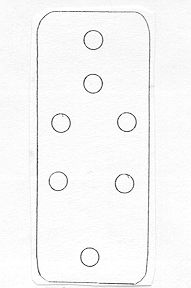 Figure 1 Figure 1
Figure 2 shows how an individual row is laced, in front, back, and side views. Lacing is done horizontally in a zigzag pattern. Pay special note to when your row is finished, because you reverse-lace back the way you came.
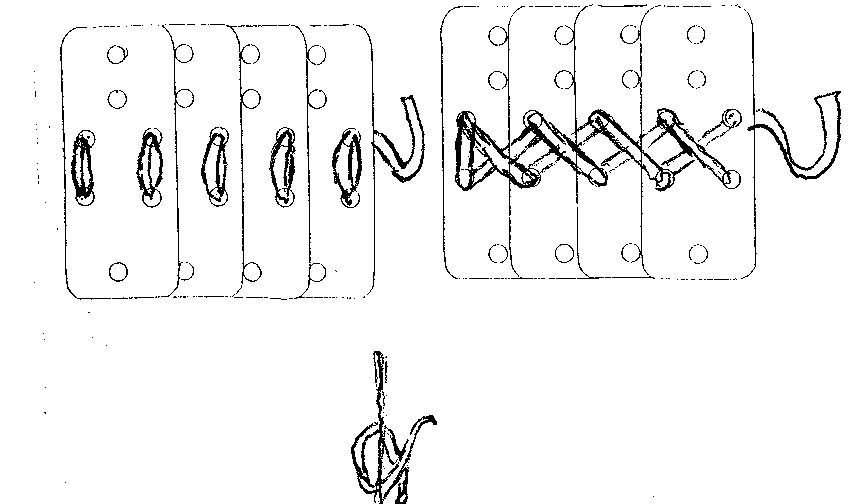 Figure 2 Figure 2
Once you've completed enough rows, its time to lace rows together. Several rows laced together make an armor plate. Align the top two holes with the bottom hole; adjoining each row as shown below.
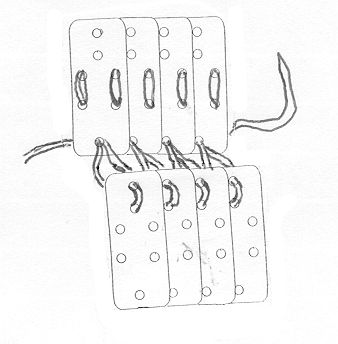 Figure 3 Figure 3
To Build the skirts, I use what is called the "San Pao" lamellae, after a find in San Pao, East Turkestan. My lamellae are 1 1/2 inches wide and 4 1/2 inches long. They are pierced with nine holes, as shown in Figure 4.
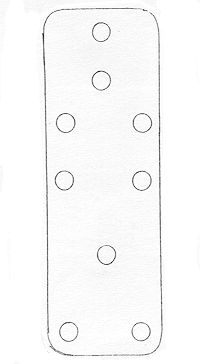 Figure 4 Figure 4
The lacing style for the San Pao lamellae is slightly different horizontally (Figure 6) but is laced much more loosely vertically (Figure 7).
There is No Figure 5
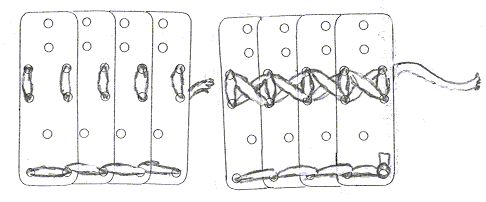 Figure 6 Figure 6
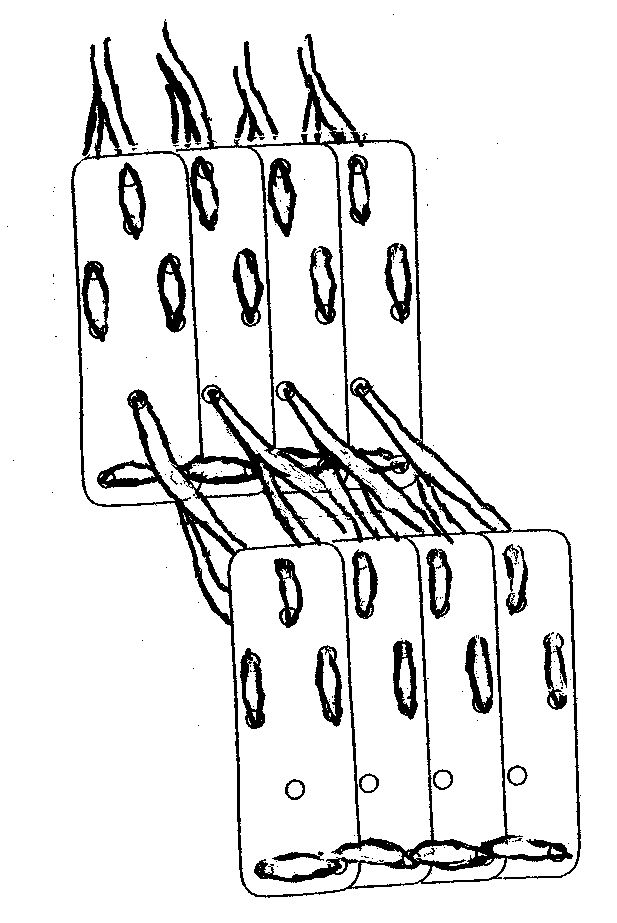 Figure 7 Figure 7
To build the sleeves, we use the 12-hole “willow-leaf”lacing pattern. My lamellae are wider than those from period, in the interest of saving time. They measure the same size as the San Pao lamellae (Figure 8).
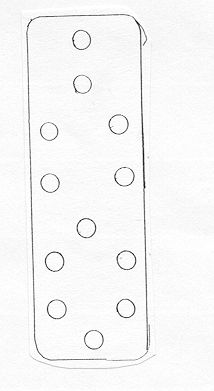 Figure 8 Figure 8
This is how they look laced, in front, back and side views.(Figure 9)
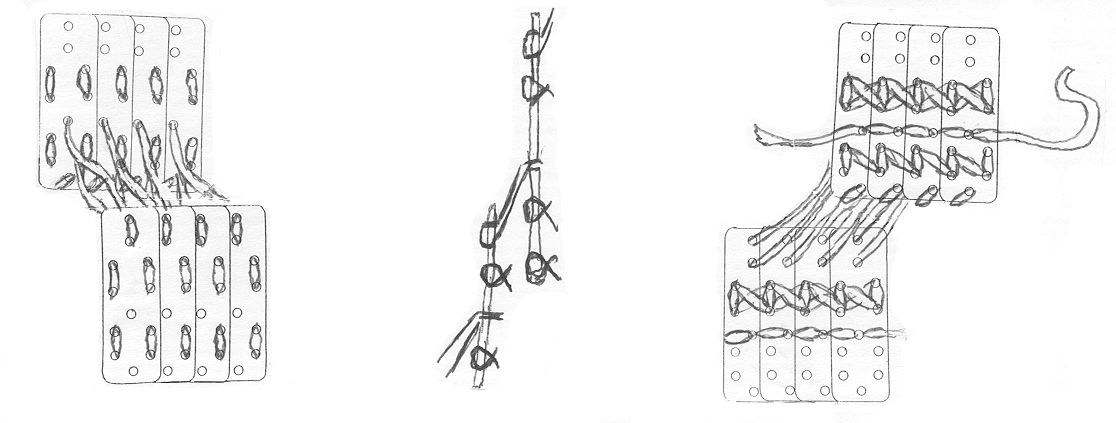 Figure 9 Figure 9
How To Put It All Together
List of Tools and Materials
A. 1 Seamstress' measuring tape
B. 1 pr. Scissors
C. 2 Butane lighters
D. 1 or more 100 yard spools of 6mm braided Maxicord™
E. 1 Roper-Whitney™ #5 Junior metal punch with a 9/32 inch punch or an electric drill with a 9/32 inch bit
F. 1 File or grinder
G. 5-7 1 inch buckles
H. 4 feet of 1 inch leather strap.
These are the measurements I take to build a knee-length lamellar klibanion, djawshan or hauberk, with sleeve flaps.
Measurements
A. Circumference of the trunk at widest point (chest, waist or hips).
B. Length from waist to pectoral muscle for men or underside of breast for women.
C. Width of chest, with arms crossed at elbow and extended.
D. Length over shoulder, collar-bone to top of shoulder blade.
E. Width of upper back, at shoulder joints
F. Measurement D, plus length from point of shoulder to 2 inches above elbow.
G. Length from waist to 2 *inches above knee.
(The following instructions assume the use of Maxicord™.)
Take measurement A and divide by two. Take this length and align a row of pre-punched "international" lamellae, overlapping so that the side holes line up, until it is at this length. Measure out four times that length in Maxicord™. Use your cigarette lighter to melt one end of the of the cord then form the melted cord into a blunt "needle." USE EXTREME CARE NOT TO BURN YOURSELF OR OTHERS! Begin lacing your first horizontal row, being careful to keep your lace cord taut. (Figure 10)
 Figure 10 Figure 10
When finished, wrap the row around your trunk at its widest point. On men, one end of the row should be placed at the furrow of the spine, the opposite should cover either the navel or the sternum. On women, one end should be on the furrow of the spine and the other at the cleavage, or from the base of the spine to the crotch. Add extra lamellae if needed. Multiply 1/2 measurement A by eight (or six, if short waisted) and add 4 (or 3) single lamellae for the spine. This is the number of lamellae in your LOWER TORSO (Figure 11).
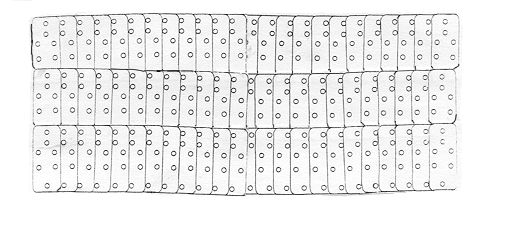 Figure 11 Figure 11
Now, take measurement C, divide by two, and lace four rows of lamellae to this length. This number usually doesn't exceed seven lamellae per row per side. Ensure that each side overlaps in the opposite direction. Attach to opening in Lower Torso. This is the number of lamellae in your UPPER CHEST. (Figure 12)
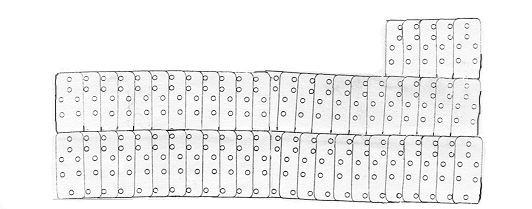 Figure 12 Figure 12
Lace Measurement E in the same style as shown below (Figure 13). You only need 3 rows like this. After linking these rows, you have the lamellae for the UPPER BACK. (Figure 14). Attach to the rear-center of LOWER TORSO.
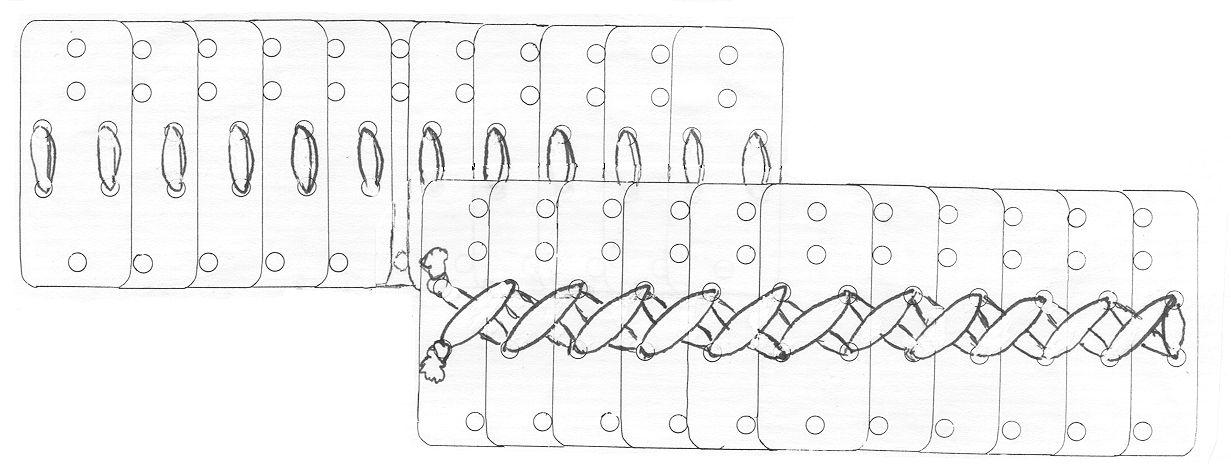
Figure 13
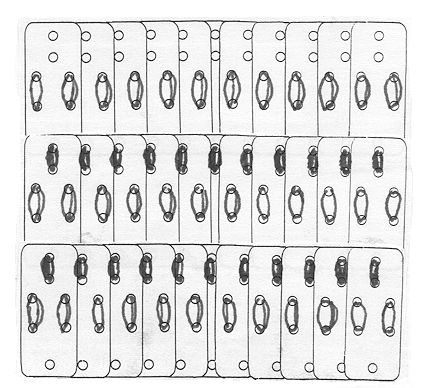
Figure 14
For the shoulder-bands, Measurement D is used. Both rows of lamellae should overlap in the opposite direction, as before. At this point, the end-lamellae on each row should be punched as shown (Figure 15), then laced to the UPPER BACK and UPPER CHEST (FIGURES 16,17). Your TORSO ARMOUR IS COMPLETE.
Figure 15
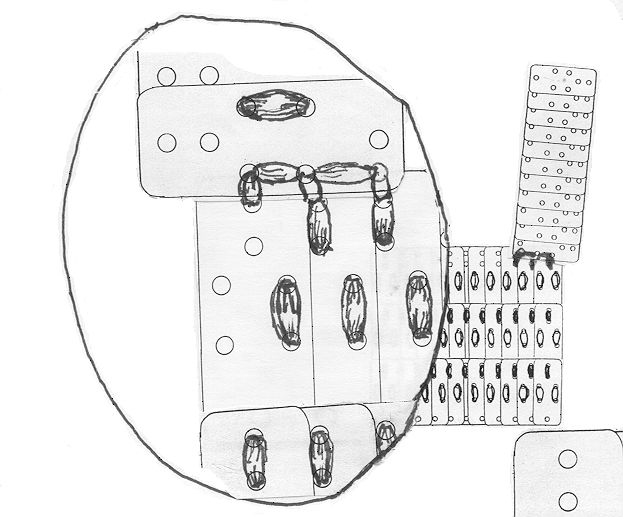 Figure 16 Figure 16
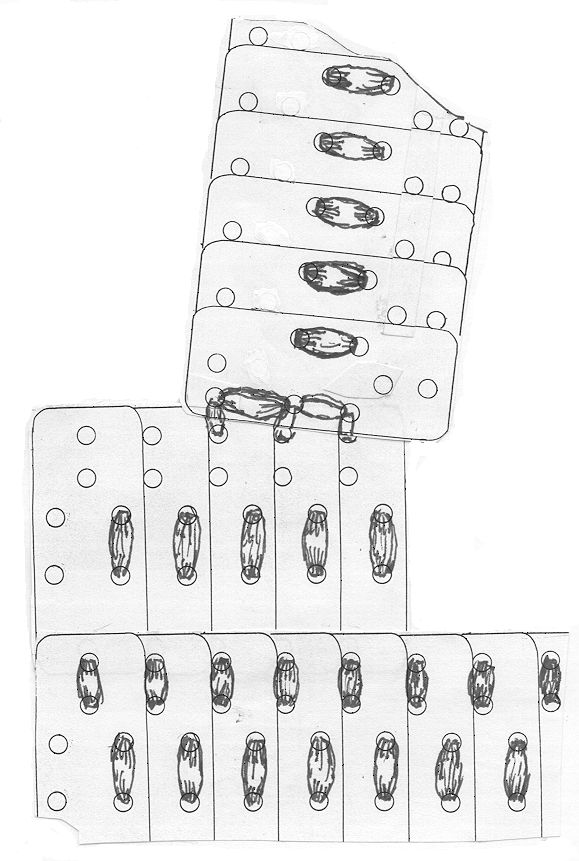 Figure 17 Figure 17
To attach skirts, you must first make WAIST PLATES. Take Measurement A, count out the number of "international" lamellae. You must now an eighth hole to each plate as shown (Figure 18) and lace as normal.
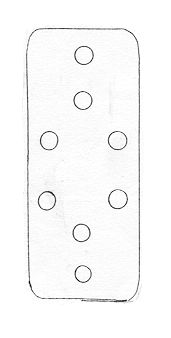 Figure 18 Figure 18
Now you must decide if you want a two-way or three-way or three-way split to your skirts. For a two-way spit per side, count the number of lamellae in Measurement A, divide by two and subtract one for the spinal lamellae. Add rows until your reach the desired length. (Figure 19)
 Figure 19 Figure 19
A three-way skirt involves Measurement E, extended to the desired length. Next count the remaining number of lamellae per side, and lace as normal (Figure 20).
FIGURE 20 NOT AVAILABLE
The formula for the sleeve-flaps are as follows. Using Measurement D, lace the “willow-leaf” pattern. Usually, three rows per flap are sufficient (Figure 21).
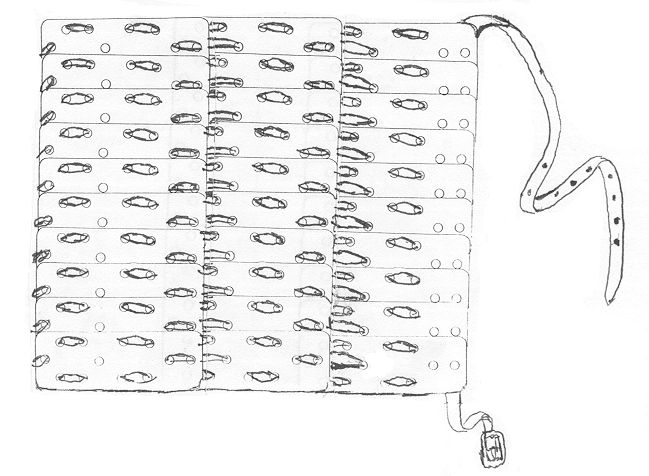 Figure 21 Figure 21
Add buckles and straps and THE ARMOUR IS FINISHED!
Practical Applications to Persona in the Current Middle Ages
One can find many practical applications for lamellar armour for your own persona, particularly if you do a little research. The late Roman army, their successors in the Byzantine, Merovingian, Lombard and Carolingian armies, used lamellar. So did their enemies, who included the Huns, Sassanid Persians, Syrians, Avars, Magyars, Turks, Ghassanids, and the numerous Migration Period tribes. During the Viking period, any Scandinavian in contact with Byzantium, particularly Varangian Guardsmen and their descendants, would have brought this armour west. In fact, there is archaeological evidence of lamellar from the Swedish village of Birka.
Italo-Normans, Franks and Anglo-Saxon knights were known to use lamellar to supplement mail Crusaders would have brought back lamellar from the Holy Land, again as a supplement to mail. They either took it from their enemies or had it fabricated for themselves.
By the thirteenth century CE, the Mongols would have exposed Central Europe, as far west as Vienna, to this style of armour. Many of us are also aware of the lamellar cuirass dug up with the other armours at the Gotlander town of Wisby. This gives one an idea of just how widespread the use of lamellar actually was.
Beyond the late fourteenth century, lamellar fell from favor in Western Europe, while coats-of-plates, brigandines and the so-called “alwhite harness” gained in popularity. However, in places like Eastern Europe, Russia, the Middle East, Persia, Central Asia and even in an anemic Byzantine Empire, lamellar stubbornly clung on until the mid-seventeenth century. In fact, my bibliography lists two suits in use during the early part of the twentieth century from Tibet and China.
I hope this class has given you, at worst, some ideas to work with, and at best an urge to study further. A bit of time spent in research can make a difference between having a unique, authentic style of harness instead of something duct taped together to get you through armour inspection, the “general format” style of armour common in the Society today, or armour pulled from the artwork of science-fantasy.
If we as rattan fighters, wish to be viewed as serious historic re-creators, rather than just practitioners of a sport, planning our equipment to resemble period exemplars is a huge step in the right directions. This class is, hopefully, a step in that direction.
Bibliography
History and Construction
Bishop, M.C. (edit.), The Production and Distribution of Roman Military Equipment 03AR International Series 275, Oxford 1985).
Bivar, A.D.H., Cavalry Equipment and Tactics on the Euphrates Frontier, Dumbarton Oaks Papers XXVI (1972).
Coulston, J.C. (edit.), Military Equipment and the Identity of Roman Soldiers (BAR International Series 394, Oxford 1988).
Shadrake, Dan and Susanna (edit.) Brittania and Arthur, (Montvert Publications,, Ancient Warrior Series Volume I Winter 1994/5).
Thordeman, Bengt, Armour for the Battle of Wisby, 1361. Volumes I and II, Stockholm 1939.
Thordeman, Bengt, Asiatic Splint Armour in Europe (Acta Archaelogica, Volume IV Fasc. 2 Kohenhavn, 1933).
Blair, Claude European Armour, Circa 1066 to Circa 1700, Macmillan Company, New York, 1959.
Nicholle, David Arms and Armour of the Crusading Era 1050-1350," Kraus International Publications, New York 1988.
Nicholle, David, '.Early Medieval Islamic Arms and Armour" Gladius, Tomo Especial, 1976.
(Nicholle, David, Numerous books published by Osprey Military Press, inquire with the author.)
Zhongyi, Yuan, The Terracotta Army of Emperor Qin Shi Huang (China Travel & Tourism Press,, Hong Kong 1993)
Examples
Tibetan iron lamellar coat and helmet, ninth century (The Board of Trustees of the Royal Armouries, No. XXVIA- 18). Example of 3 -way skirt in lamellar.
Tibetan iron lamellar for man and horse, ninth century (The Board of Trustees of the Royal Armouries, No. XXVIA-157, 186).
Leather lamellar armour from Szechwan, used up to early twentieth century (The Board of Trustees of the Royal Armouries, No. XXVIA-106).
Carved Antler showing helmeted warrior in lamellar, Birka ninth-tenth century (National Museum of Antiquities, Stockholm).
Rock bas-relief of Sassanid monarch Choroes 11, Taq-i-Bustan, Iran.
Leather-laced plate and lamellar from Yunnan, eighth-thirteenth century (The Board of Trustees of the Royal Armouries, No. XXVIA-161).
Tibetan iron lamellar armour (Museum of Anthropology and Ethnography, St. Petersburg).
Chukchi iron lamellar armour (Museum of Anthropology and Ethnography, St. Petersburg).
Chukchi bone lamellar armour (Museum of Anthropology and Ethnography, St. Petersburg).
Tibetan lamellar cuirass (Ethnographical Museum, Stockholm).
Leather lamellar from Szechwan (Museum fuer Voelkerkunde, Dresden)
Iron lamellar find from San Pao, East Turkestan, tenth-thirteenth century.
Single iron lamellae from Etsin Gol, East Turkestan, tenth-thirteenth century.
Armour of iron lamellae No. 25, Common Grave 2, Wisby fourteenth century (Antikvarisktopografiska arkivet, Stockholm).
Carved relief, early twelfth century, north door of Church of St. Nicholas, Bari.
Lamellar fragment from Idalion, Cyprus (Cyprus collection, Stockholm.)
Two lamellar helmets from an Avarian tomb at Kertch, Crimea (State Historical Museum, Moscow).
Armour fragment of leather lamellar from Dura-Europos (Gallery of Fine Arts, Yale University).
| 
